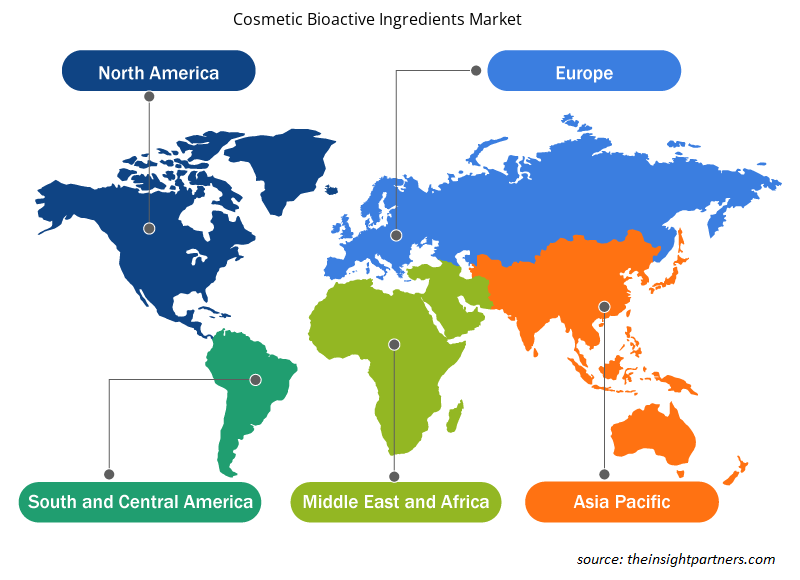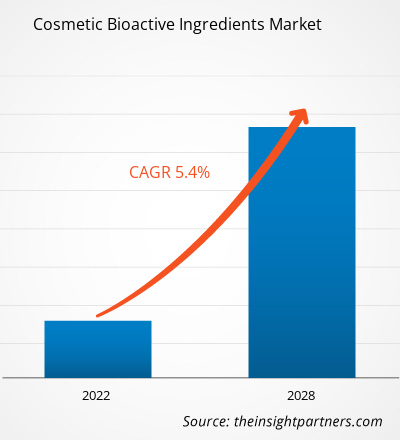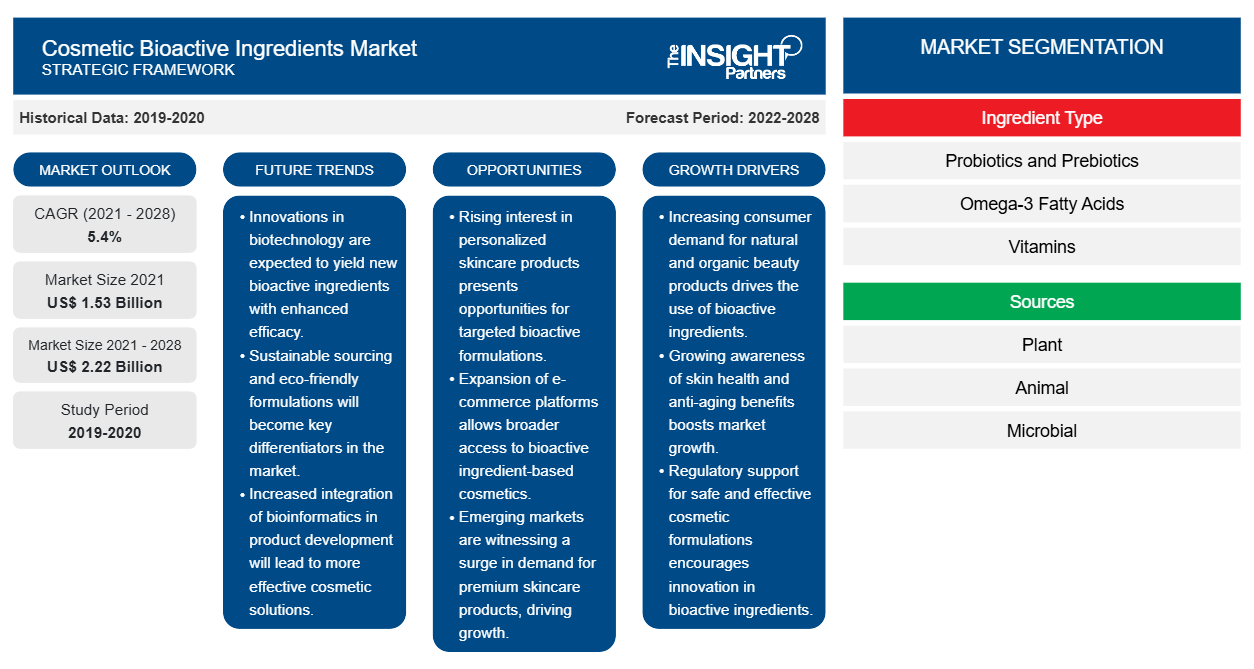Der Markt für kosmetische bioaktive Inhaltsstoffe soll von 1.529,91 Millionen US-Dollar im Jahr 2021 auf 2.215,96 Millionen US-Dollar im Jahr 2028 anwachsen; von 2021 bis 2028 wird mit einer durchschnittlichen jährlichen Wachstumsrate von 5,4 % gerechnet.
Kosmetika sind Produkte, die auf Haut und Haar aufgetragen werden, um sie zu reinigen, zu verschönern, attraktiver zu machen oder das Aussehen zu verbessern. Unter den Wirkstoffen, die üblicherweise in dieser Art von Präparaten verwendet werden, gibt es einen weltweiten Trend, Produkte pflanzlichen Ursprungs zu verwenden, da sie kommerziell attraktiv, sicher und reichhaltig sind und oft mit einer synergistischen oder multifunktionalen Wirkung verbunden sind. Pflanzenextrakte sind reich an sekundären Metaboliten, die in Pflanzen mit hoher struktureller Vielfalt vorkommen. Sowohl Flavonoide als auch Nicht-Flavonoide werden mit interessanten kosmetischen Eigenschaften wie Lichtschutz, Anti-Aging, Feuchtigkeitsversorgung, Antioxidationsmittel, adstringierende Wirkung, reizlindernde Wirkung und antimikrobielle Wirkung in Verbindung gebracht. Mit ihren bioaktiven Komponenten und pharmakologischen Wirkungen haben sich diese bioaktiven Inhaltsstoffe als dermatologische Vorteile erwiesen, mit potenziellen Anwendungen für Hautverjüngung, Lichtschutz, Wundheilung und mehr. Das Wachstum des Marktes für kosmetische bioaktive Inhaltsstoffe ist in erster Linie auf die zunehmende Präferenz für natürliche Inhaltsstoffe in Kosmetikprodukten und die zunehmende Anzahl bioaktiver Inhaltsstoffe zurückzuführen, die auf den Markt gebracht werden. Strenge regulatorische Rahmenbedingungen schränken jedoch das Wachstum des Marktes für kosmetische bioaktive Inhaltsstoffe ein .
Passen Sie diesen Bericht Ihren Anforderungen an
Sie erhalten kostenlose Anpassungen an jedem Bericht, einschließlich Teilen dieses Berichts oder einer Analyse auf Länderebene, eines Excel-Datenpakets sowie tolle Angebote und Rabatte für Start-ups und Universitäten.
- Holen Sie sich die wichtigsten Markttrends aus diesem Bericht.Dieses KOSTENLOSE Beispiel umfasst eine Datenanalyse von Markttrends bis hin zu Schätzungen und Prognosen.
Markteinblicke
Die steigende Nachfrage der Verbraucher nach Naturprodukten treibt die Forschung zu bioaktiven Substanzen voran, die in Kosmetika verwendet werden können. In Europa sind einige der größten Hersteller bioaktiver Inhaltsstoffe und Körperpflegemarken ansässig, darunter BASF und DSM. Die Einführung bioaktiver Inhaltsstoffe für die Körperpflegebranche treibt das Wachstum des Marktes voran. Im Juni 2019 brachte BASF Care Creations drei neue Wirkstoffe für den Schönheitsmarkt auf den Markt, die Rambutanbäume verwenden, die die Haut mit Feuchtigkeit versorgen und regenerieren. Ebenso brachte Lonza im April 2019 den bioaktiven Inhaltsstoff H2OBioEV auf den Markt, eine einzigartige Kombination aus Inhaltsstoffen natürlichen Ursprungs – Aphanothece Sacrum-Polysaccharide und Galactoarabinan – mit Wasser und Glycerin. Der Inhaltsstoff verleiht Feuchtigkeitseigenschaften, indem er wichtige Feuchthaltemittel auffüllt, was ein optimales Umfeld für die Bildung und Aufrechterhaltung einer starken epidermalen Proteinbarriere schafft.
Erkenntnisse auf Basis der Inhaltsstoffart
Basierend auf der Art der Inhaltsstoffe ist der Markt für kosmetische bioaktive Inhaltsstoffe in Probiotika und Präbiotika, Omega-3-Fettsäuren, Vitamine, Carotinoide und Antioxidantien, Pflanzenextrakte, Mineralien, Aminosäuren, Proteine und Peptide und andere unterteilt. Das Aminosäurensegment wird im Jahr 2021 wahrscheinlich den größten Marktanteil haben. Es wird jedoch erwartet, dass das Segment Pflanzenextrakte im Prognosezeitraum die höchste durchschnittliche jährliche Wachstumsrate auf dem Markt verzeichnet.
Quellenbasierte Erkenntnisse
Der Markt für kosmetische bioaktive Inhaltsstoffe ist nach Quellen in pflanzliche, tierische und mikrobielle Inhaltsstoffe unterteilt. Das pflanzliche Segment dürfte 2021 den größten Marktanteil halten. Es wird jedoch erwartet, dass das mikrobielle Segment im Prognosezeitraum die höchste durchschnittliche jährliche Wachstumsrate auf dem Markt verzeichnet.
Unternehmen, die auf dem Markt für bioaktive Inhaltsstoffe in der Kosmetik tätig sind, verfolgen Strategien wie Produkteinführungen, Fusionen und Übernahmen, Kooperationen, Produktinnovationen und Produktportfolios, um ihre Präsenz weltweit auszubauen, ihren Markennamen zu wahren und die wachsende Nachfrage der Endverbraucher zu erfüllen.
Regionale Einblicke in den Markt für bioaktive kosmetische Inhaltsstoffe
Die regionalen Trends und Faktoren, die den Markt für kosmetische bioaktive Inhaltsstoffe während des gesamten Prognosezeitraums beeinflussen, wurden von den Analysten von Insight Partners ausführlich erläutert. In diesem Abschnitt werden auch die Marktsegmente und die Geografie für kosmetische bioaktive Inhaltsstoffe in Nordamerika, Europa, im asiatisch-pazifischen Raum, im Nahen Osten und Afrika sowie in Süd- und Mittelamerika erörtert.

- Erhalten Sie regionale Daten zum Markt für bioaktive Inhaltsstoffe in Kosmetika
Umfang des Marktberichts über bioaktive Inhaltsstoffe für Kosmetika
| Berichtsattribut | Details |
|---|---|
| Marktgröße im Jahr 2021 | 1,53 Milliarden US-Dollar |
| Marktgröße bis 2028 | 2,22 Milliarden US-Dollar |
| Globale CAGR (2021 - 2028) | 5,4 % |
| Historische Daten | 2019-2020 |
| Prognosezeitraum | 2022–2028 |
| Abgedeckte Segmente | Nach Zutatentyp
|
| Abgedeckte Regionen und Länder | Nordamerika
|
| Marktführer und wichtige Unternehmensprofile |
|
Dichte der Marktteilnehmer für bioaktive Inhaltsstoffe für Kosmetika: Auswirkungen auf die Geschäftsdynamik verstehen
Der Markt für kosmetische bioaktive Inhaltsstoffe wächst rasant, angetrieben durch die steigende Nachfrage der Endverbraucher aufgrund von Faktoren wie sich entwickelnden Verbraucherpräferenzen, technologischen Fortschritten und einem größeren Bewusstsein für die Vorteile des Produkts. Mit steigender Nachfrage erweitern Unternehmen ihr Angebot, entwickeln Innovationen, um die Bedürfnisse der Verbraucher zu erfüllen, und nutzen neue Trends, was das Marktwachstum weiter ankurbelt.
Die Marktteilnehmerdichte bezieht sich auf die Verteilung der Firmen oder Unternehmen, die in einem bestimmten Markt oder einer bestimmten Branche tätig sind. Sie gibt an, wie viele Wettbewerber (Marktteilnehmer) in einem bestimmten Marktraum im Verhältnis zu seiner Größe oder seinem gesamten Marktwert präsent sind.
Die wichtigsten Unternehmen auf dem Markt für bioaktive Inhaltsstoffe in der Kosmetik sind:
- Koninklijke DSM NV
- Ajinomoto Co., Inc.
- Roquette Freres
- ADM
- BASF SE
Haftungsausschluss : Die oben aufgeführten Unternehmen sind nicht in einer bestimmten Reihenfolge aufgeführt.

- Überblick über die wichtigsten Akteure auf dem Markt für bioaktive Inhaltsstoffe für Kosmetika
Markt für bioaktive Inhaltsstoffe in der Kosmetik – vonZutatentyp
- Probiotika und Präbiotika
- Omega-3-Fettsäuren
- Vitamine
- Carotinoide und Antioxidantien
- Pflanzenextrakte
- Mineralien
- Aminosäuren
- Proteine und Peptide
- Sonstiges
Markt für kosmetische bioaktive Inhaltsstoffe – nach Quelle
- Anlage
- Tier
- Mikrobiell
Markt für kosmetische bioaktive Inhaltsstoffe – nach Geografie
Nordamerika
- UNS
- Kanada
- Mexiko
Europa
- Frankreich
- Deutschland
- Italien
- Vereinigtes Königreich
- Spanien
- Restliches Europa
Asien-Pazifik (APAC)
- China
- Indien
- Südkorea
- Japan
- Australien
- Restlicher Asien-Pazifik-Raum
Naher Osten und Afrika (MEA)
- Südafrika
- Saudi-Arabien
- Vereinigte Arabische Emirate
- Restlicher Naher Osten und Afrika
Südamerika (SAM)
- Brasilien
- Argentinien
- Restliches Süd- und Mittelamerika
Firmenprofile
- Koninklijke DSM NV
- Ajinomoto Co., Inc.
- Roquette Freres
- ADM
- BASF SE
- FMC Corporation
- Vytrus Biotech
- Cargill, Inc.
- Sensient Technologies Corporation
- DUPONT
- Historische Analyse (2 Jahre), Basisjahr, Prognose (7 Jahre) mit CAGR
- PEST- und SWOT-Analyse
- Marktgröße Wert/Volumen – Global, Regional, Land
- Branchen- und Wettbewerbslandschaft
- Excel-Datensatz
Aktuelle Berichte
Verwandte Berichte
Erfahrungsberichte
Grund zum Kauf
- Fundierte Entscheidungsfindung
- Marktdynamik verstehen
- Wettbewerbsanalyse
- Kundeneinblicke
- Marktprognosen
- Risikominimierung
- Strategische Planung
- Investitionsbegründung
- Identifizierung neuer Märkte
- Verbesserung von Marketingstrategien
- Steigerung der Betriebseffizienz
- Anpassung an regulatorische Trends























 Kostenlose Probe anfordern für - Markt für kosmetische bioaktive Inhaltsstoffe
Kostenlose Probe anfordern für - Markt für kosmetische bioaktive Inhaltsstoffe